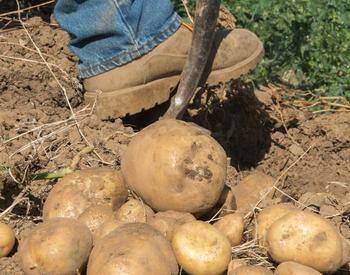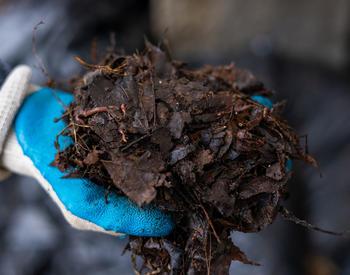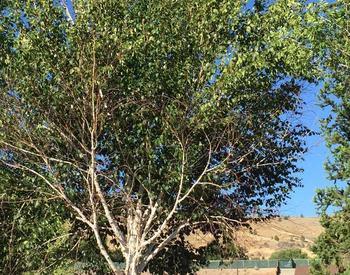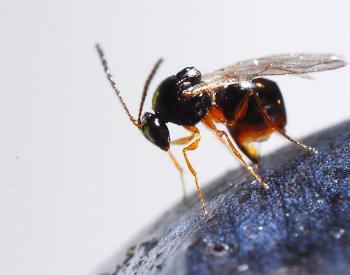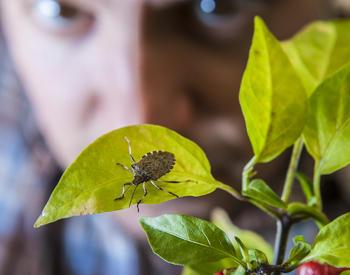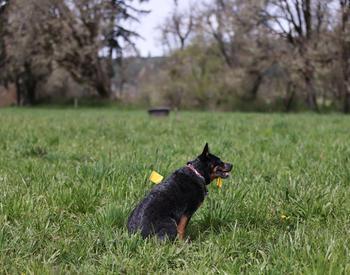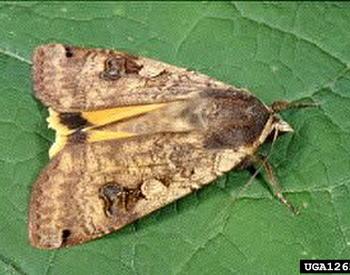Introduction
Controlling thrips (onion and western flower) is becoming increasingly difficult for commercial onion growers in the Treasure Valley. One of the problems is resistance to some of the commonly used insecticides. The objective of this trial was to screen registered and non-registered insecticides to find those which have potential for use in thrips control programs. Not all insecticides referred to in this report are registered for use on onions. Always obtain and read the insecticide label to ensure that the product is registered for the crop for which it is intended.
Materials and Methods
A block of onions 29 feet wide by 320 feet in length, soil type Greenleaf silt loam, was planted with the onion variety ‘Vaquero’ (Nunhems, Parma, ID) on March 18, 2010. The onions were planted as two double rows on a 44-inch bed. The double rows were spaced 2 inches apart. The seeding rate was 137,000 seeds/acre. Lorsban 15G was applied in a 6-inch band over each row at planting at a rate of 3.7 oz/1000 ft of row for onion maggot control. Water was applied by drip irrigation. The block was divided into 30-ft plots, each 2 beds wide. There were 10 treatments and each treatment replicated 4 times.
Treatments were made by CO2 pressurized plot sprayer with four nozzles spaced 19 inches apart. It was set to apply 35.0 gal/acre, with water as the carrier. A non-ionic surfactant was added to all treatments, and Cyazypyr, Movento, Acephate and Lannate were buffered to pH 6.0. Treatments were applied on a weekly basis beginning on June 3. Thrips counts were made on a weekly basis by visually counting the total number of thrips on fifteen plants in each plot. Insecticides tested included Agri-Mek, Cyazypyr, Requiem (high and low pressure), Movento, Acephate, and a combination of Movento plus Cyazypyr. These products were compared to an untreated check and a grower standard. The grower standard consisted of two consecutive applications of Radiant followed by two successive Movento applications, then three consecutive Lannate applications on a 7-10 day interval. Radiant is a new insecticide from Dow AgriScience that is closely related to Success. Movento is a new, systemic insecticide being introduced by Bayer. Cyazypyr is a new product being tested by DuPont to determine its effectiveness on thrips. Agri-Mek is a Syngenta product that has received a Section 18 emergency label in Colorado, Washington and New York this year. Acephate is an old product used mostly on tree fruit. Requiem is a bio-pesticide which is reported to be effective on thrips. Foliage injury ratings were taken as a subjective measurement of foliage damage caused by thrips feeding and iris yellow spot virus disease (IYSV) symptoms. A scale of 0-5 (0 = no injury, 5 = complete silvering of the leaves) was used. The treatments are listed in Table 1.
| Treatment | Rates/acre |
|---|---|
| Agri-Mek | 1.0 pt |
| Standard 1 | - |
| Untreated Check (UTC) | - |
| Cyazypyr | 13.5 oz |
| Requiem (80 psi) | 2.0 qt |
| Requiem (40 psi) | 2.0 qt |
| Movento + DyneAmic | 5.0 oz .25% v/v |
| Movento+ DyneAmic+ AMS (Ammonium Sulfate) | 5.0 oz .25% v/v 1.0 lb. |
| Acephate | 1.0 pt |
| Movento+ Cyazypyr | 5.0 oz 13.5 oz |
The application dates and environmental conditions are listed in Table 2. The onions were harvested September 9-10, 2010, and graded September 14-15, 2010.
| Application Date | Time | Temperature (degrees F) | Relative Humidity | Wind |
|---|---|---|---|---|
| June 3 | 4:30 PM | 68 | 49 | 7.7 |
| June 14 | 7:00 AM | 59 | 59 | 6.8 |
| June 22 | 7:30 AM | 52 | 85 | 3.8 |
| June 29 | 6:30 AM | 65 | 72 | 6.9 |
| July 6 | 8:00 AM | 59 | 58 | 7.0 |
| July 13 | 5:00 AM | 79 | 22 | 3.1 |
| July 20 | 6:45 AM | 57 | 53 | 3.7 |
Results and Discussion
Thrips counts were made by counting the total number of thrips on each of fifteen plants in each plot (Table 3). Evaluations of thrips and iris yellow spot virus damage to the onion foliage were taken on July 26. The evaluations are shown in Table 4. Season average thrips populations are illustrated in Figure 1.
Thrips populations along with foliage damage from feeding and iris yellow spot damage were light compared with 2009 data. The best thrips control was the standard treatment but the Acephate, Movento, Movento+Cyazypyr and Agri-Mek treatments were not significantly different from the standard.
Cyazypyr alone did not control thrips, nor did adding it to Movento increase thrips control over Movento alone.
The addition of AMS (ammonium sulfate) to Movento appeared to have a negative impact on thrips control compared to Movento alone.
Requiem did not give adequate thrips control at either high pressure (80 psi) or low pressure (40 psi). The high pressure treatment had a significantly higher foliage damage rating similar to the untreated check.
Requiem (both treatments), Cyazypyr, and the untreated check all had higher levels of foliage damage than the other treatments.
| Treatment | 8-Jun | 16-Jun | 24 Jun | 1-Jul | 16-Jul | 26-Jul | Season Average |
|---|---|---|---|---|---|---|---|
| Agri-Mek | 5.3 | 6.6 | 13.0 | 14.3 | 9.5 | 17.3 | 10.8 |
| Standard 1 | 5.2 | 8.4 | 13.0 | 3.9 | 6.9 | 20.3 | 8.0 |
| Untreated Check (UTC) | 6.4 | 16.1 | 13.7 | 18.2 | 14.7 | 20.2 | 15.7 |
| Cyazypyr | 6.0 | 10.4 | 11.4 | 18.0 | 15.0 | 18.6 | 13.7 |
| Requiem (80 psi) | 9.5 | 17.7 | 13.6 | 22.5 | 17.2 | 20.2 | 17.7 |
| Requiem (40 psi) | 9.9 | 19.2 | 12.9 | 18.1 | 15.7 | 19.3 | 16.5 |
| Movento | 5.8 | 13.8 | 8.8 | 7.6 | 7.8 | 7.3 | 9.5 |
| Movento+ AMS | 8.0 | 14.6 | 10.5 | 8.4 | 11.4 | 8.9 | 11.2 |
| Acephate | 4.5 | 10.3 | 3.6 | 9.6 | 9.5 | 19.8 | 8.3 |
| Movento+Cyazypyr | 5.9 | 9.0 | 12.2 | 7.2 | 5.2 | 21.0 | 8.4 |
| LSD (0.05 | 7.7 | 5.5 | 5.1 | 4.6 | NS | 3.1 | |
| LSD (0.1) | 3.1 |
| Treatment | Thrips damage rating (1-5) 2 |
|---|---|
| Agri-Mek | 1.1 |
| Standard 1 | 0.4 |
| Untreated Check (UTC) | 3.0 |
| Cyazypyr | 1.8 |
| Requiem (80 psi) | 2.8 |
| Requiem (40 psi) | 2.0 |
| Movento | 0.8 |
| Movento + AMS | 1.1 |
| Acephate | 0.6 |
| Movento + Cyazypyr | 0.6 |
| LSD (0.05) | 0.7 |
A comparison of the thrips damage rating vs. average thrips population (Figure 2) showed a very strong relationship (R2 = 0.8989). The higher the thrips population, the more severe the damage from thrips feeding and IYSV.
Yield and grade are shown in Table 5. There were significant differences between treatments in total yield and all the size categories except the jumbo classification. Generally, the treatments with the best thrips control also had the highest total yield and the highest yield of colossal and super colossal sized bulbs. The grower standard, Acephate, Movento and Agri-Mek all had higher total yield compared to the other products tested.
There was a strong correlation between thrips populations and total yield (Figure 3) where the R2 value of the relationship was 0.892. Failure to adequately control thrips had a negative impact on yield.
| Treatment | Medium | Jumbo | Colossal | Super Colossal | Yield Total |
|---|---|---|---|---|---|
| Agri-Mek | 28.0 | 783.1 | 123.1 | 8.0 | 942.3 |
| Standard 1 | 31.8 | 760.5 | 141.6 | 14.0 | 947.9 |
| Untreated Check (UTC) | 91.0 | 682.4 | 13.7 | 0.0 | 787.0 |
| Cyazypyr | 45.8 | 732.8 | 75.7 | 4.4 | 858.8 |
| Requiem (80 psi) | 69.2 | 674.1 | 28.4 | 1.8 | 773.4 |
| Requiem (40 psi) | 62.9 | 675.8 | 36.2 | 7.9 | 782.8 |
| Movento | 31.8 | 738.2 | 119.8 | 10.5 | 903.9 |
| Movento + AMS | 31.8 | 744.2 | 93.8 | 21.0 | 890.8 |
| Acephate | 28.3 | 745.1 | 159.2 | 18.9 | 951.6 |
| Movento + Cyazypyr | 48.9 | 682.1 | 158.9 | 11.8 | 901.6 |
| LSD (0.05) | 26.0 | NS | 55.7 | 12.9 | 93.0 |
Conclusions
Agri-Mek, Movento and Acephate all performed well compared to the standard. Acephate is unlikely to get registered by the EPA and should not be used by growers. Requiem and Cyazypyr did not give effective thrips control.
If the EPA will again allow states to choose two options for thrips control in 2011, then it is recommended that both Movento and Agri-Mek be requested for use under a Section 18 emergency label.
